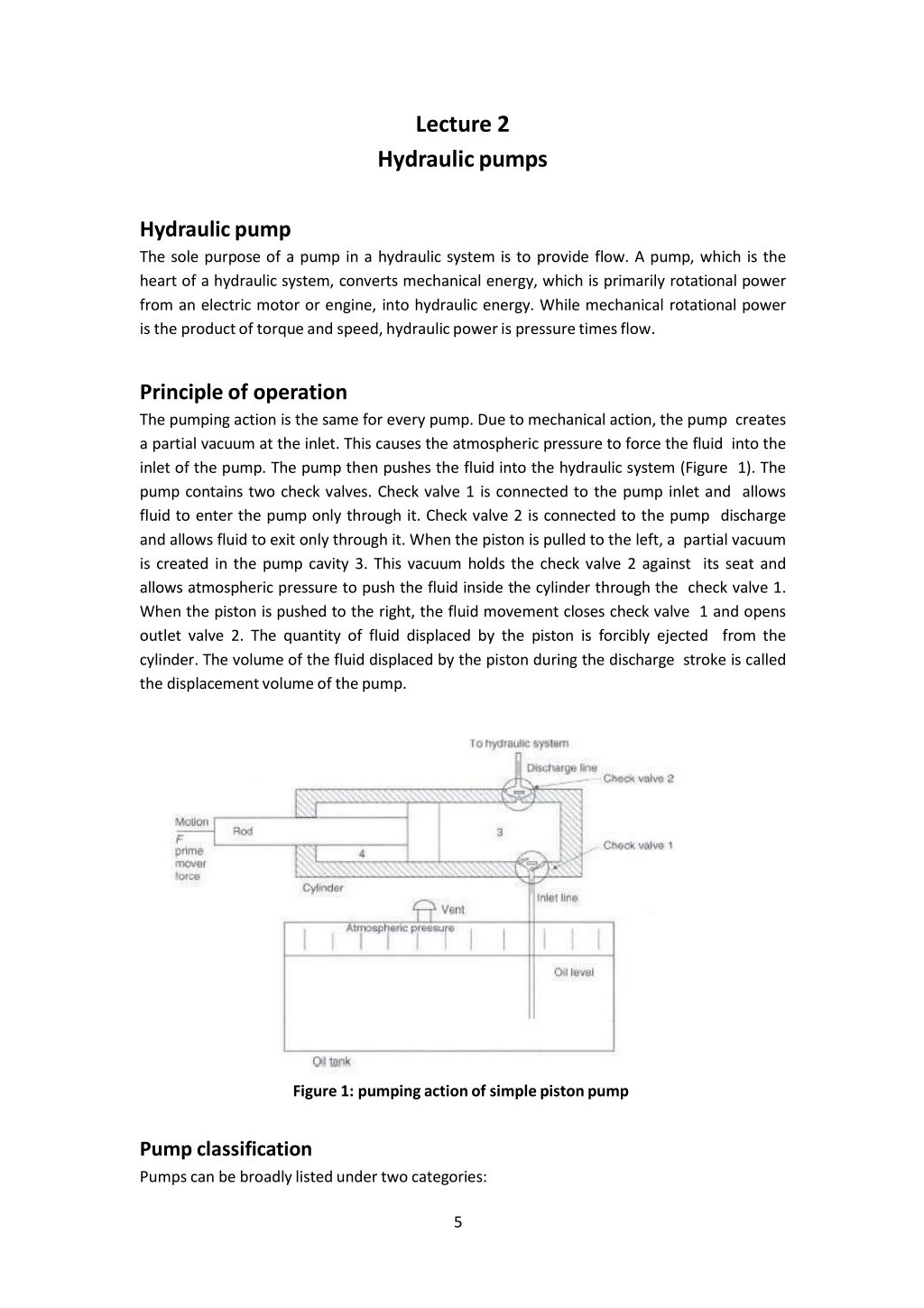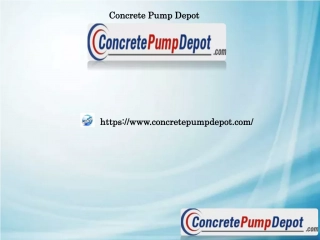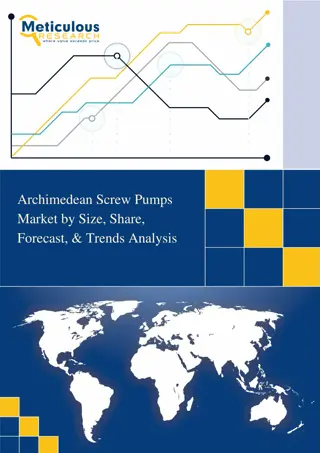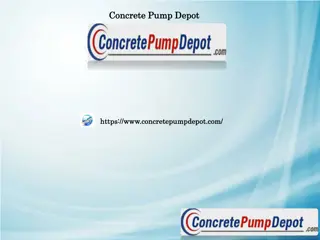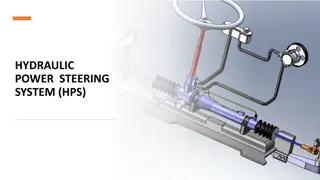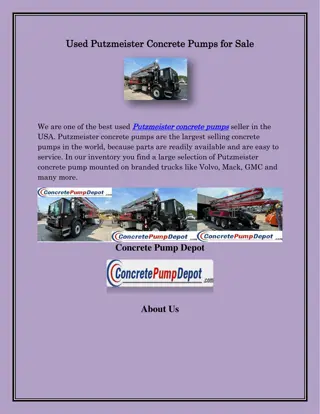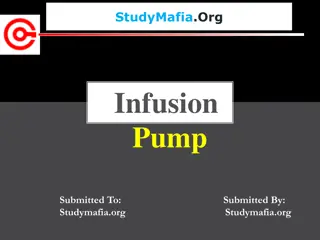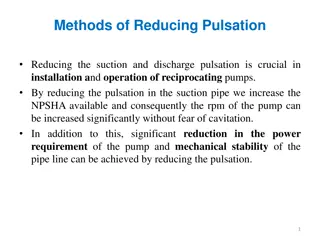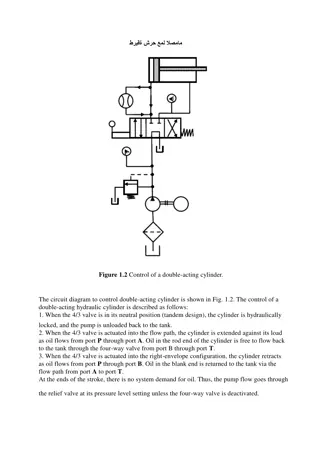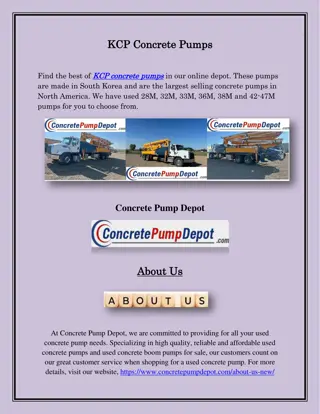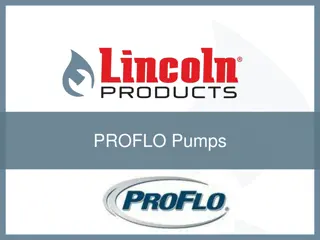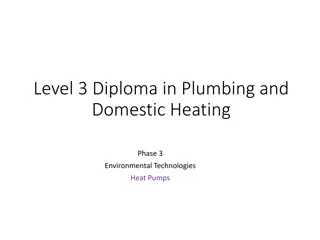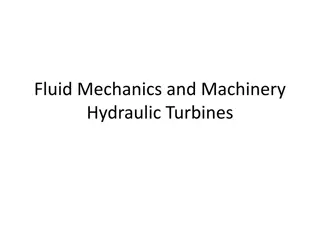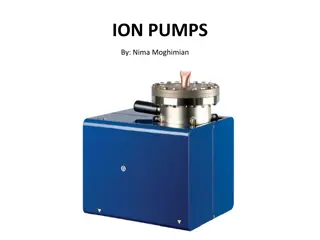Hydraulic Pumps: Types and Functions
Hydraulic pumps are essential components in hydraulic systems, converting mechanical energy into hydraulic energy to provide flow. There are two main categories of pumps - non-positive displacement pumps and positive displacement pumps. Non-positive displacement pumps, such as centrifugal pumps, work based on fluid pressurization by propeller rotation, while positive displacement pumps deliver a constant volume of fluid per cycle. Positive displacement pumps, like gear pumps, offer advantages such as high pressure capability, efficiency, and reliability, making them widely used in industrial fluid power applications.
Download Presentation

Please find below an Image/Link to download the presentation.
The content on the website is provided AS IS for your information and personal use only. It may not be sold, licensed, or shared on other websites without obtaining consent from the author.If you encounter any issues during the download, it is possible that the publisher has removed the file from their server.
You are allowed to download the files provided on this website for personal or commercial use, subject to the condition that they are used lawfully. All files are the property of their respective owners.
The content on the website is provided AS IS for your information and personal use only. It may not be sold, licensed, or shared on other websites without obtaining consent from the author.
E N D
Presentation Transcript
Lecture 2 Hydraulicpumps Hydraulic pump The sole purpose of a pump in a hydraulic system is to provide flow. A pump, which is the heart of a hydraulic system, converts mechanical energy, which is primarily rotational power from an electric motor or engine, into hydraulic energy. While mechanical rotational power is the productof torqueand speed,hydraulicpoweris pressuretimesflow. Principle of operation The pumping action is the same for every pump. Due to mechanical action, the pump creates a partial vacuum at the inlet. This causes the atmospheric pressure to force the fluid into the inlet of the pump. The pump then pushes the fluid into the hydraulic system (Figure 1). The pump contains two check valves. Check valve 1 is connected to the pump inlet and allows fluid to enter the pump only through it. Check valve 2 is connected to the pump discharge and allows fluid to exit only through it. When the piston is pulled to the left, a partial vacuum is created in the pump cavity 3. This vacuum holds the check valve 2 against its seat and allows atmospheric pressure to push the fluid inside the cylinder through the check valve 1. When the piston is pushed to the right, the fluid movement closes check valve 1 and opens outlet valve 2. The quantity of fluid displaced by the piston is forcibly ejected from the cylinder. The volume of the fluid displaced by the piston during the discharge stroke is called the displacementvolumeof thepump. Figure 1: pumping action of simple pistonpump Pumpclassification Pumps can be broadly listed under twocategories: 5
1. Non-positive displacement pumpsand 2. Positive displacementpumps. A. Non-Positive DisplacementPumps These pumps are also known as hydro-dynamic pumps. In these pumps the fluid is pressurized by the rotation of the propeller and the fluid pressure is proportional to the rotor speed. These pumps can not withstanding high pressures and generally used for low-pressure and high-volume flow applications. The important advantages of non- positive displacement pumps are lower initial cost, less operating maintenance because of less moving parts, simplicity of operation, higher reliability and suitability with wide range of fluid etc. These pumps are primarily used for transporting fluids and find little use in the hydraulic or fluid power industries. Centrifugal pump is the common example of non-positivedisplacementpumps. B. Positive displacementpump These pumps deliver a constant volume of fluid in a cycle. The discharge quantity per revolution is fixed in these pumps and they produce fluid flow proportional to their displacement and rotor speed. These pumps are used in most of the industrial fluid power applications. The output fluid flow is constant and is independent of the system pressure (load). The important advantage associated with these pumps is that the high- pressure and low-pressure areas (means input and output region) are separated and hence the fluid cannot leak back due to higher pressure at the outlets. These features make the positive displacement pump most suited and universally accepted for hydraulic systems. The important advantages of positive displacement pumps over non- positive displacement pumps include capability to generate high pressures, high efficiency, high power to weight ratio, change in efficiency throughout the pressure rangeis small and wideroperatingrangepressureand speed. volumetric Pump Positive displacement Non-positive displacement Centrifugal Axial Radial Rotary Reciprocating Gear Vane Screw GearPumps Gear pump is a robust and simple positive displacement pump. It has two meshed gears revolving about their respective axes. These gears are the only moving parts in the pump. They are compact, relatively inexpensive and have few moving parts. The rigid 6
design of the gears and houses allow for very high pressures and the ability to pump highly viscous fluids. They are suitable for a wide range of fluids and offer self-priming performance. Sometimes gear pumps are designed to function as either a motor or a pump. These pump includes helical and herringbone gear sets (instead of spur gears), lobe shaped rotors similar to Roots blowers (commonly used as superchargers), and mechanical designs that allow the stacking of pumps. Based upon the design, the gear pumps are classified as: External gear pumps Lobe pumps Internal gear pumps Gerotorpumps Generally gear pumps are used to pump: Petrochemicals: Pure or filled bitumen, pitch, diesel oil, crude oil, lube oil etc. Chemicals: Sodium silicate, acids, plastics, mixed chemicals, isocyanates etc. Paint and ink Resins and adhesives Pulp and paper: acid, soap, lye, black liquor, kaolin, lime, latex, sludge etc. Food: Chocolate, cacao butter, fillers, sugar, vegetable fats and oils, molasses, animal food etc. 1. External gear pump A schematic of an external gear pump is shown in Figure2. An external gear pump consists of two gears usually equal in size, which mesh externally and are housed in a pump case. Each gear is mounted on a shaft, which is supported by needle bearings in the case covers. One of these shafts is coupled to a prime mover and is called the drive shaft. The gear mounted on this shaft is called the drive gear. It drives the second gear as it rotates. Two side plates are provided one on each side of the gear. The side plates are held between the gear case and case covers. The rotating gear carries the fluid from the tank to the outlet pipe. The suction side is towards the portion whereas the gear teeth come out of the mesh. When the gears rotate, volume of the chamber expands leading to pressure drop below atmospheric value. Therefore the vacuum is created andthe fluid is pushed into the void due to atmospheric pressure. The fluid is trapped between housing and rotating teeth of the gears. The discharge side of pump is towards the portion where the gear teeth run into the mesh and the volume decreases between meshing teeth. The pump has a positive internal seal against leakage; therefore, the fluid is forced into the outlet port. The gear pumps are often equipped with the side wear plate to avoid the leakage. The clearance between gear teeth and housing and between side plate and gear face is very important and plays an important role in preventing leakage. In general, the gap distance is less than 10 micrometers. The amount of fluid discharge is determined by the number of gear teeth, the volume of fluid between each pair of teeth and the speed of rotation. The important drawback of external gear pump is the unbalanced side load on its bearings. It is caused due to high 7
pressure at the outlet and low pressure at the inlet which results in slower speeds and lower pressure ratings in addition to reducing the bearing life. Gear pumps are most commonly used for the hydraulic fluid power applications and are widely used in chemical installationsto pumpfluidwith a certain viscosity. Figure2: Gear pump 2. Lobe Pump Lobe pumps work on the similar principle of working as that of external gear pumps. However in Lobe pumps, the lobes do not make any contact like external gear pump (see Figure 3). Lobe contact is prevented by external timing gears located in the gearbox. Similar to the external gear pump, the lobes rotate to create expanding volume at the inlet. Now, the fluid flows into the cavity and is trapped by the lobes. Fluid travels around the interior of casing in the pockets between the lobes and the casing. Finally, the meshing of the lobes forces liquid to pass through the outlet port. The bearings are placed out of the pumped liquid. Therefore the pressure is limited by the bearing location and shaftdeflection. Figure 3: lope pump Lobe pumps are frequently used in food applications because they handle solids without damaging the product. Large sized particles can be pumped much effectively than in other positive displacement types. As the lobes do not make any direct contact 8
therefore, the clearance is not as close as in other Positive displacement pumps. This specific design of pump makes it suitable to handle low viscosity fluids with diminished performance. 3. Internal Gear Pump Internal gear pumps are exceptionally versatile. They are often used for low or medium viscosity fluids such as solvents and fuel oil and wide range of temperature. This is non- pulsing, self-priming and can run dry for short periods. It is a variation of the basic gear pump. It comprises of an internal gear, a regular spur gear, a crescent-shaped seal and an external housing. The schematic of internal gear pump is shown in figure 4. Liquid enters the suction port between the rotor (large exterior gear) and idler (small interior gear) teeth. Liquid travels through the pump between the teeth and crescent. Crescent divides the liquid and acts as a seal between the suction and discharge ports. When the teeth mesh on the side opposite to the crescent seal, the fluid is forced out through the discharge port of the pump. This clearance between gears can be adjusted to accommodate high temperature, to handle high viscosity fluids and to accommodate the wear. These pumps are bi-rotational so that they can be used to load and unload the vessels. As these pumps have only two moving parts and one stuffing box, therefore they are reliable, simple to operate and easy to maintain. However, these pumps are not suitable for high speed and high pressure applications. Only one bearing is used in the pumpthereforeoverhungload on shaftbearingreducesthe life of the bearing. Applications Some commoninternalgear pumpapplicationsare: All varietiesof fuel oil and lube oil Resinsand Polymers Alcoholsand solvents Asphalt,Bitumen,and Tar Polyurethanefoam (Isocyanateand polyol) Food productssuchas corn syrup, chocolate,and peanut butter Paint,inks,and pigments Soapsand surfactants Glycol 9
Crescent Figure 4: Internal gearpump 4. GerotorPump Gerotor is a positive displacement pump. The name Gerotor is derived from "Generated Rotor". At the most basic level, a Gerotor is essentially one that is moved via fluid power. Originally this fluid was water, today the wider use is in hydraulic devices. The schematic of Gerotor pump is shown in figure 5. Gerotor pump is an internal gear pump without the crescent. It consists of two rotors viz. inner and outer rotor. The inner rotor has N teeth, and the outer rotor has N+1 teeth. The inner rotor is located off-center and both rotors rotate. The geometry of the two rotors partitions the volume between them into N different dynamically-changing volumes. During the rotation, volume of each partition changes continuously. Therefore, any given volume first increases, and then decreases. An increase in volume creates vacuum. This vacuum creates suction, and thus, this part of the cycle sucks the fluid. As the volume decreases, compression occurs. During this compressionperiod,fluids can be pumped,or compressed(if they are gaseousfluids). The important advantages of the pumps are high speed operation, constant discharge in all pressure conditions, bidirectional operation, less sound in running condition and less maintenance due to only two moving parts and one stuffing box etc. However, the pump is having some limitations such as medium pressure operating range, clearance is fixed, solidscan tbe pumpedand overhungload on the shaftbearing etc. Figure 5: Gerotorpump 10
Applications Gerotors are widely used in industries and are produced in variety of shapes and sizes by a number of different methods. These pumps are primarily suitable for low pressure applications such as lubrication systems or hot oil filtration systems, but can also be found in low to moderate pressure hydraulic applications. However common applications are as follows: Light fuel oils Lube oil Cooking oils Hydraulicfluid 11
